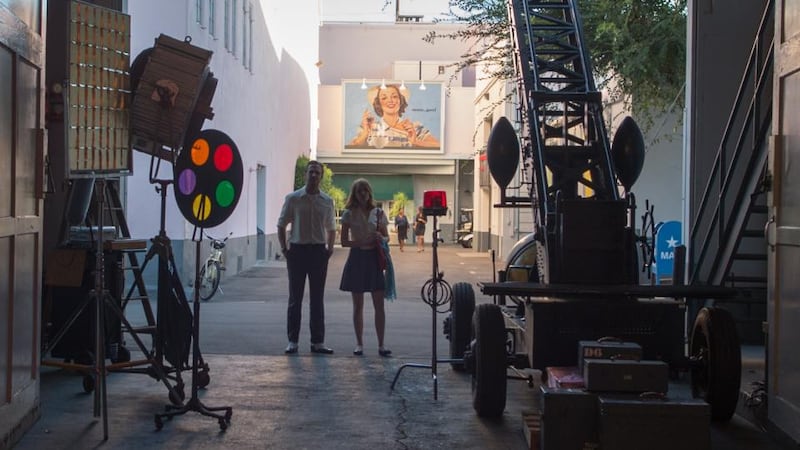A heady sequence in this year's Oscar favourite La La Land has the lovers played by Emma Stone and Ryan Gosling strolling across the bustling Warner Bros backlot, past camera crews and actors, and stopping to stare at "the window that Humphrey Bogart and Ingrid Bergman looked out of in Casablanca". It's a vision of the film studio as dream factory, a location of fun and glamour, where ambitions are achieved and show-business history is made, harking back to other great behind-the-scenes movies, such as Singin' in the Rain.
The reality is more prosaic. Most studios are large, windowless sheds that don't look very different from any other light-industrial factory buildings. But it's what goes on behind those walls – Stars! Spaceships! Dragons! – that continues to exert a fascination, which may explain why there's such interest in plans to significantly increase their number in Ireland.
Recent reports have focused on the proposal by the Irish film industry stalwarts James Morris and Alan Moloney to build a big studio complex at Poolbeg, in Dublin's south docklands. But that's not all. Next month Harbour Studios opens in Belfast, joining the city's Titanic Studios, home for the past six years to HBO's Game of Thrones. In Limerick the new Troy Studios, based in the old Dell factory, is touting its wares, and there are reports of plans to build a huge "production village" in a vacant factory in Tralee.


Meanwhile, filming resumes next week on the latest series of Vikings, at Ashford Studios in Co Wicklow, where its proprietor, Joe O'Connell, hopes to build a €90 million second phase, including four new sound stages and a TV studio.
Fifteen minutes' drive up the N11 from Ashford, however, the venerable Ardmore – Ireland's only purpose-built 20th-century studio – is up for sale, with some wondering whether it might end up being redeveloped for housing.
In an art form built on the ephemeral – what the director John Boorman has described as "money into light" – studios are bricks-and-mortar evidence that an actual industry exists.
First Hollywood studios
The first great Hollywood studios sprang up 100 years ago in faraway southern California to service early moviemakers fleeing the enforcement of Thomas Edison’s patent rights to cinema technology. The studios came first and the sprawling conurbation of Los Angeles followed.
By the mid-1920s Hollywood films represented the fifth-largest industry in the United States, and the “studio system” – a vertically integrated business that controlled everything from who got cast in which movie to how much tickets cost for the matinee show – was in full swing. Ever since, the idea that a sustainable film industry requires a large studio infrastructure has remained, despite the destruction of the old Hollywood system by anti-trust laws.
For smaller films, shooting on location may make more sense, but for most of the effects-driven blockbusters that dominate contemporary movie screens the bulk of the work is done in the carefully controlled studio environment and in digital postproduction. While the media focused on the few seconds of Star Wars footage shot in Co Kerry, 80 per cent of those films are shot at Pinewood Studios, just outside London.
In Canada and the UK tens of thousands of people are employed in the myriad of ancillary activities that surround big studios. Across the world, countries seek to attract productions by offering attractive tax write-offs and up-to-date facilities.
Such aspirations were a long way from the realities of the Irish State in its early years. When Seán Lemass, as minister for industry and commerce, proposed the construction of a national film studio, in the late 1940s, he was rebuffed by the minister for finance, Frank Aiken, on the basis that "if this country is going to spend money on the film business, it should be spent on the production of Irish films by Irish organisations and not in the provision of facilities which at present suit foreigners but which might well be too elaborate for the requirements of domestic producers". This stern refrain would be repeated in subsequent decades.
Ten years later a conglomerate of impresarios and local businesspeople did manage to raise the finance to build a studio. With substantial financial backing from Lemass’s department they settled on an elevated site at Ardmore, within easy reach of a range of scenic Co Wicklow locations for outdoor scenes.
Over the following half-century the story of Ardmore would mirror the economic and cultural history of the country. The studio never met the high expectations of its founders, who hoped it might draw on the expertise and talents of the Abbey Theatre. Instead, in his speech opening the studio, Lemass focused on the economic benefits rather than any cultural arguments for an Irish film industry.
For a long time thereafter Ardmore was effectively a closed shop, employing only British film technicians and servicing British-based productions. It managed to attract a few major movies – Boorman, who had settled in Wicklow, made Zardoz and Excalibur there – but it teetered permanently on the brink of commercial failure and had to be rescued repeatedly by the State. (It's currently home to RTÉ's new Sunday-night series Dancing with the Stars.)
Miracle
In retrospect it’s a miracle Ardmore didn’t close down during the 1980s recession. Its survival was largely due to the broadcaster turned producer Morgan O’Sullivan, whose talent for making deals with international television productions would sustain the studio almost up to the present day. (O’Sullivan brought
Vikings
to Ashford.) Along the way Ardmore has played a part in some of the landmarks of a growing Irish film industry, from
My Left Foot
to
Braveheart
, but has never quite managed to shake off its white-elephant tag. Its greatest problem now, in an era of increased competition, may simply be that it’s too small.
Over the years the tension reflected in Frank Aiken’s comment has resurfaced from time to time. If the State wanted to encourage film-making in Ireland should it support local producers and directors to make their own, smaller projects or should it try to attract big-budget international productions that, in theory at least, might provide more employment? As the early Ardmore experience showed, studios didn’t necessarily provide opportunities for local film technicians. But the key to developing a viable industry was continuous production, and infrastructure was an essential part of that.
So why the explosion of film-studio space in recent years? Richard Williams, chief executive of Northern Ireland Screen, says four factors influence where a major production gets made: financial incentives, appropriate studio facilities, crew and locations. Williams says some compare studios to the hotel business. "It's not a bad analogy," he says. "For a time there, for example, we were short on studio capacity until Belfast Harbour Studios came along."
“These big projects don’t have an immediate impact on the local girl or guy who has a story they want to tell,” Williams adds. “But we have a fantastic infrastructure now, and it’s all built on the big stuff.”
Troy Studios declined to talk to The Irish Times for this article, because it is "working towards final refurbishment and at this point the timing is not right". But there are questions about how viable it is to build a studio in a region that has no real history of film production, and very little infrastructure or local crew. As Ardmore's early history shows, there is limited benefit to be had from shipping in everything from outside.
Where is all the demand coming from for these facilities? The biggest change by far in the global audiovisual industry has been the extraordinary rise over the past decade of episodic television drama, the best of which now surpasses most cinema feature films in intellectual scope and creative ambition.
The phenomenon has been fuelled by the way the digital revolution in the audiovisual industry, unlike the music or publishing sectors, has seen disruptors, such as Netflix and Amazon, invest huge amounts of money in content creation. Netflix will spend €5 billion this year, which is €5 billion that wasn't there five years ago.
“It’s totally true,” Williams says. “The feature-film market continues to grow by 2-3 per cent per annum. But the shift to high-end TV drama is driving a lot of demand. The UK is awash with it. There’s no reason why Ireland, north and south, can’t be a part of that. It’s a global industry with huge opportunities.”
What if, as some suggest, the TV-drama explosion is a bubble that has to burst? And what will the impact of Brexit be? Williams laughs. “Is this boom time? Yes it is,” he says. “Is this a fragile industry? Yeah. But it’s not going to stop for the foreseeable future.”
Morris and Moloney's planned Dublin Bay Studios is based on a similar analysis of the opportunities that exist, although its targets are more ambitious. The 20-acre complex proposed for the Poolbeg peninsula is based on the Canadian model of the Cité du Cinéma film studios, in Montreal, which since the 1980s has built up a "creative cluster" around its downtown site. To achieve this, the Dublin project proposes eight "very large" sound stages and a range of other facilities, including a five-acre greenfield backlot. Its 180,000sq ft of sound stages would compare with the 40,000sq ft at Ardmore and 45,000sq ft at Ashford, as well as Troy's 70,000sq ft.
Morris, the founder of Windmill Lane Studios and TV3, and former chairman of the Irish Film Board, has decades of experience in film facilities in Ireland and the UK, including recent forays into computer-generated special-effects work. He believes the studios would create 1,800 direct jobs and a further 1,800 indirect ones. They would also, he believes, provide a nationwide benefit, as they would serve as a catalyst for location filming throughout Ireland.
The proposal ran into complications as it became clear that the political realities of the housing crisis meant that most of the land in the surrounding Poolbeg West strategic development zone would be used for homebuilding. The studio project therefore needs some land currently owned by Dublin Port Company, which has shown little enthusiasm for the idea.
But Morris is equally unenthusiastic about a suggestion from Dublin City Council that land could be provided instead at Ballymun, in the city's northern suburbs, citing potential sound-pollution problems from the nearby airport. More fundamentally, he regards Poolbeg's city-centre location, with proximity to the technology companies around Silicon Docks and to third-level institutions, as essential, all part of a package that would appeal to international talent. (The powerful international talent agency CAA is a partner on the project.)
“The proposition is for a city-centre studio, and our business case is based on that premise,” Morris says. “To be a film studio but also a catalyst for a cluster of all the many technologies, crafts, specialists, talent, finance, arts, culture, university R&D and digital services that you need for modern production – not only for film but video games and virtual-reality production. A creative-industry cluster alongside Silicon Docks would put Dublin and Ireland on the map as a creative hot spot which not only creates sustainable opportunities for our own talent but attracts in the best talent.
“That combination of elements makes Dublin Bay Studios a primary studio location and therefore infinitely more competitive internationally than the very many studios around Europe located in peripheral industrial parks, good as many of them are.”
Perfect match
On the face of it the Poolbeg project looks a perfect match for the objectives laid out last month by Taioseach Enda Kenny when he launched the Government’s Creative Ireland strategy. One of the five pillars of that strategy is the development of the country’s media-production industries, with the focus on “Ireland’s potential to be a global leader in film production, TV drama, documentary, children’s storytelling, and animation for the screen”. Another pillar commits to “investing in our creative and cultural infrastructure”.
For Morris the opportunity is clear. Europe’s biggest hub for audiovisual production is Greater London, with more than 100 sound stages and enormous special-effects and postproduction facilities, but the mayor of London, Sadiq Khan, says at least 20 more stages are required. Paris and Prague are among the other cities competing for business. Morris argues that, with the right infrastructure, Dublin can compete with any of these and can deliver the continuity of production that will allow people to make their careers in film-making in Ireland.
“If you had production going on for 12 months of every year you could see how more people could make their lives here,” he says. “I think the launch of Creative Ireland, highlighting audiovisual production, communicates something very positive internationally about Ireland’s cultural credibility.”


















